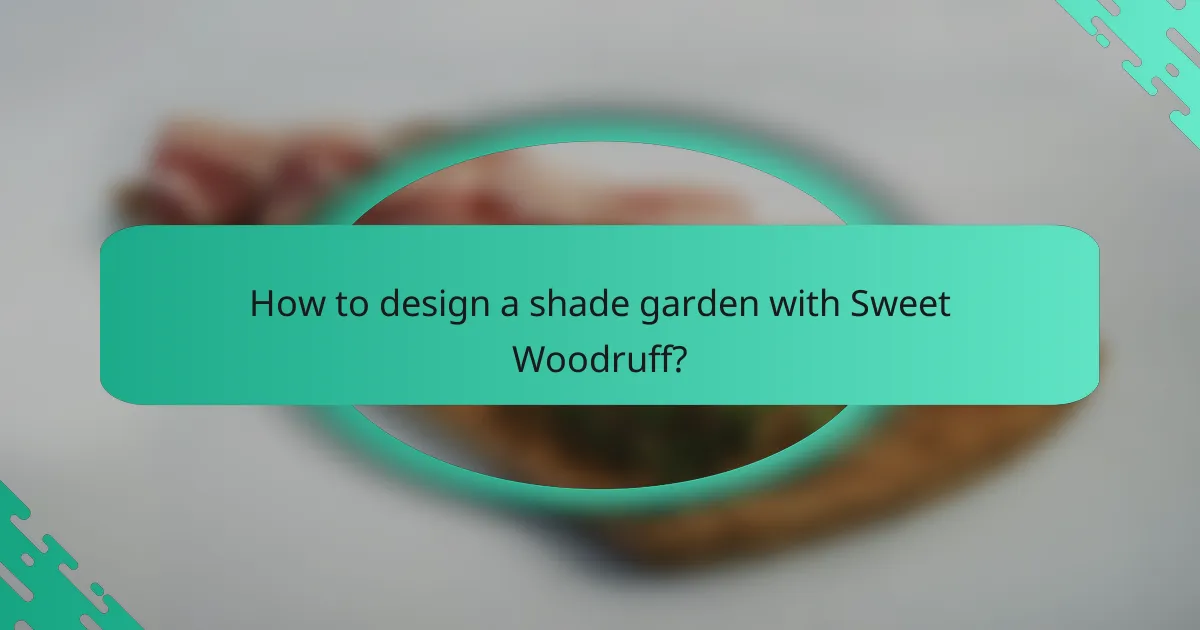Designing a shade garden with Sweet Woodruff can transform low-light areas into vibrant, lush spaces. This perennial ground cover not only enhances beauty but also suppresses weeds and retains soil moisture, making it an ideal choice for woodland gardens. With its ability to thrive in moist, shaded environments, Sweet Woodruff adds fragrance and attracts wildlife, enriching both garden aesthetics and biodiversity.

How to design a shade garden with Sweet Woodruff?
Designing a shade garden with Sweet Woodruff involves creating a lush, green space that thrives in low-light conditions. This perennial ground cover not only adds beauty but also helps suppress weeds and retain soil moisture.
Layered planting techniques
Layered planting techniques enhance visual interest and biodiversity in a shade garden. Start with Sweet Woodruff as a ground cover, then add taller plants like ferns or hostas to create vertical layers. This approach maximizes space and ensures that each plant receives adequate light.
Consider the height and spread of each plant when layering. Place taller plants at the back or center, depending on your garden’s layout, and use medium-height plants to fill in gaps. This creates a natural, flowing design that mimics woodland habitats.
Companion plants for Sweet Woodruff
Companion planting with Sweet Woodruff can enhance the garden’s health and aesthetics. Suitable companions include astilbe, bleeding heart, and various ferns, which thrive in similar shade conditions and complement the delicate foliage of Sweet Woodruff.
When selecting companion plants, consider their growth habits and flowering times. Mixing early bloomers with late-season plants can extend the garden’s visual appeal throughout the growing season.
Soil preparation tips
Preparing the soil is crucial for a thriving shade garden with Sweet Woodruff. Aim for well-draining, rich soil with a pH between 6.0 and 7.0. Amending the soil with organic matter, such as compost or well-rotted manure, can improve fertility and moisture retention.
Before planting, clear the area of weeds and debris. Loosen the soil to a depth of about 12 inches to promote root growth. Conducting a soil test can also help identify any nutrient deficiencies that need addressing.
Watering requirements
Sweet Woodruff prefers consistently moist soil but can tolerate short dry spells once established. Water the plants deeply once a week, adjusting frequency based on rainfall and temperature. During hot summer months, more frequent watering may be necessary to prevent stress.
Mulching around the plants can help retain moisture and regulate soil temperature. Use organic mulch, such as shredded bark or straw, to enhance the garden’s appearance while providing additional benefits.
Seasonal maintenance
Seasonal maintenance is essential for keeping a shade garden with Sweet Woodruff healthy. In spring, remove any dead foliage and apply a layer of compost to replenish nutrients. Monitor for pests and diseases, particularly in the early growing season.
In fall, cut back Sweet Woodruff to promote new growth in the spring. This perennial can be divided every few years to prevent overcrowding and encourage vigorous growth. Regular maintenance ensures a vibrant and thriving shade garden year after year.

What are the benefits of using Sweet Woodruff in gardens?
Sweet Woodruff offers numerous advantages for garden design, particularly in shaded areas. Its ability to thrive in low-light conditions while providing ground cover, fragrance, and wildlife attraction makes it a versatile choice for enhancing garden aesthetics and biodiversity.
Ground cover advantages
Sweet Woodruff is an excellent ground cover plant, effectively suppressing weeds and preventing soil erosion. It spreads quickly, forming a dense mat that can cover large areas, making it ideal for shaded spots where grass may struggle to grow. Consider planting it in clusters to maximize its coverage and visual impact.
This plant typically grows to about 15-20 cm in height, making it a low-maintenance option that requires minimal care once established. Ensure it has moist, well-drained soil to thrive, and avoid planting it in overly dry or sunny locations.
Fragrance and aesthetics
One of the standout features of Sweet Woodruff is its sweet, hay-like fragrance, especially when the leaves are crushed. This aromatic quality can enhance the sensory experience of your garden, making it a pleasant spot to relax or entertain. The plant also produces small white flowers in spring, adding visual interest to shaded areas.
For a cohesive design, pair Sweet Woodruff with other shade-loving plants such as ferns or hostas. This combination can create a lush, layered look while benefiting from the contrasting textures and colors of different foliage.
Wildlife attraction
Sweet Woodruff attracts various beneficial insects, including pollinators like bees and butterflies. By incorporating this plant into your garden, you can support local ecosystems and promote biodiversity. Its dense foliage also provides shelter for small wildlife, contributing to a healthy garden environment.
To maximize wildlife attraction, consider planting Sweet Woodruff alongside other native plants that bloom at different times throughout the growing season. This strategy can create a continuous source of food and habitat for local fauna, enhancing the ecological value of your garden.

Which local conditions suit Sweet Woodruff best?
Sweet Woodruff thrives in specific local conditions that include moist, shaded environments with rich, well-draining soil. This perennial plant is particularly suited for woodland gardens and areas with indirect sunlight.
Optimal soil types in New England
In New England, Sweet Woodruff prefers loamy or sandy soils that retain moisture while allowing for good drainage. Soils rich in organic matter, such as compost or leaf mold, enhance growth and flowering.
A pH level between 5.5 and 7.0 is ideal for Sweet Woodruff, ensuring that nutrients are readily available. Conducting a soil test can help determine the necessary amendments to achieve optimal conditions.
Sunlight requirements
Sweet Woodruff flourishes in partial to full shade, making it an excellent choice for under trees or in shaded garden corners. Direct sunlight can scorch its leaves, so it’s best to limit exposure to a few hours of morning light.
In areas with dappled sunlight, Sweet Woodruff can still thrive, as long as the soil remains consistently moist. Aim for locations that receive filtered light throughout the day for the best results.
Climate considerations
This plant is well-suited to temperate climates, including the New England region, where winters are cold and summers are mild. Sweet Woodruff is hardy and can tolerate frost, making it a reliable perennial in these conditions.
During hot, dry spells, ensure adequate moisture to prevent wilting. Mulching around the base can help retain soil moisture and regulate temperature, providing a stable environment for growth.

What are common pests and diseases affecting Sweet Woodruff?
Sweet Woodruff can be susceptible to various pests and diseases that may affect its health and growth. Common issues include aphids, slugs, and fungal infections, which can hinder the plant’s development if not managed properly.
Identifying pests
Aphids are small, soft-bodied insects that can be found on the undersides of leaves, sucking sap and causing wilting. Slugs and snails may leave irregular holes in the foliage, indicating their presence. Fungal diseases, such as powdery mildew, appear as white, powdery spots on leaves and can spread quickly in humid conditions.
Preventative measures
To prevent pest infestations, maintain good air circulation around Sweet Woodruff by spacing plants appropriately. Regularly inspect the plants for early signs of pests or disease. Additionally, applying a layer of mulch can deter slugs and help retain soil moisture, reducing stress on the plants.
Treatment options
If pests are detected, insecticidal soap or neem oil can effectively eliminate aphids without harming beneficial insects. For slugs, consider using bait or traps, such as beer traps, to reduce their numbers. In the case of fungal infections, ensure proper spacing and airflow, and apply fungicides as needed to control outbreaks. Regularly removing affected leaves can also help manage the spread of disease.

How to incorporate Sweet Woodruff in urban shade gardens?
Sweet Woodruff is an excellent choice for urban shade gardens due to its low maintenance and ability to thrive in low-light conditions. To effectively incorporate this plant, consider its growth habits and compatibility with other shade-loving plants.
Container gardening ideas
Container gardening with Sweet Woodruff allows for flexibility in urban settings. Use medium-sized pots to accommodate its spreading nature while ensuring adequate drainage. Consider pairing it with other shade-tolerant plants like ferns or hostas for a lush, layered effect.
When selecting containers, opt for materials that retain moisture, such as ceramic or fiberglass. Position the containers in areas that receive dappled sunlight or full shade to promote healthy growth. Regularly check soil moisture, as Sweet Woodruff prefers consistently moist conditions.
For a striking visual, create a mixed container with Sweet Woodruff, contrasting foliage plants, and seasonal flowers. This combination can enhance the aesthetic appeal of balconies, patios, or shaded corners of your garden.


